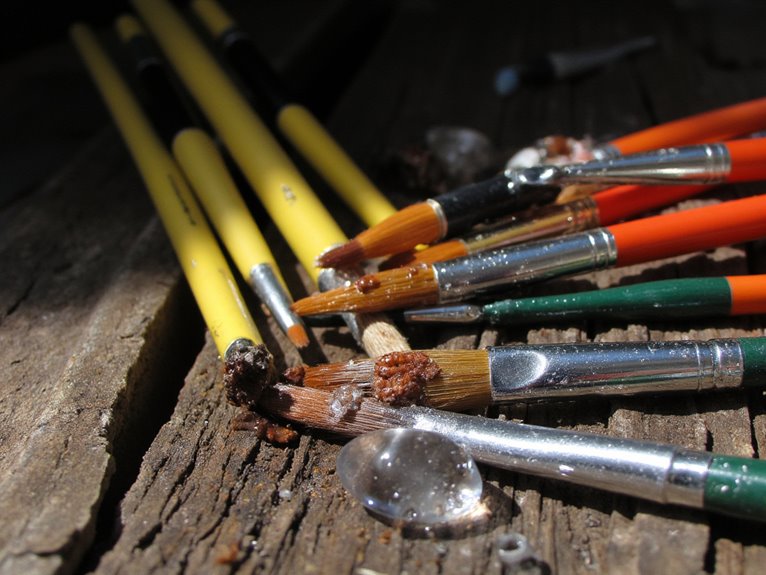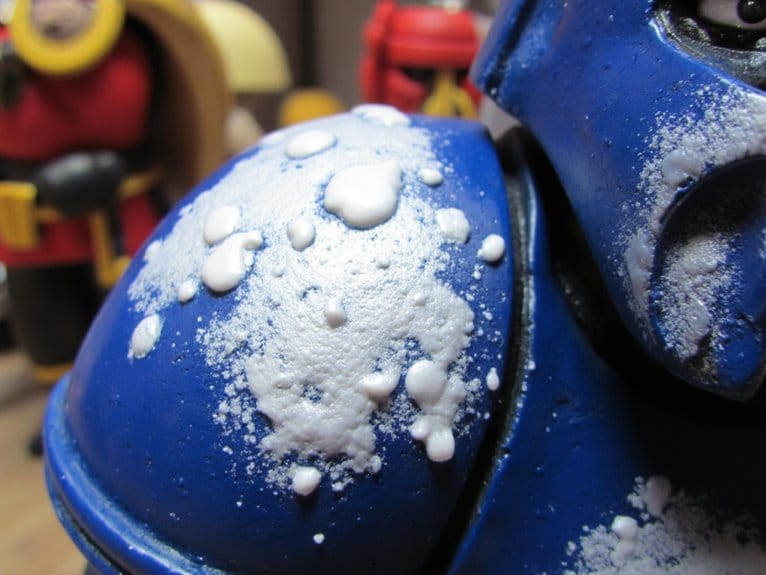We are supported by our audience. When you purchase through links on our site, we may earn an affiliate commission, at no extra cost for you. Learn more. Last update on 30th June 2025 / Images from Amazon Product Advertising API.
You’ll extend your miniature painting brush lifespan dramatically by rinsing frequently in lukewarm water and preventing paint from migrating beyond three-fourths of the bristle length toward the ferrule. Use specialized brush soaps for weekly deep cleaning, reshape tips between colors, and store brushes upright in humidity-controlled environments. Never use hot water, as it dissolves ferrule adhesives and damages natural bristles. Replace brushes when frayed bristles or excessive shedding occurs, and the following thorough techniques will maximize your investment.
Notable Insights
- Rinse brushes frequently in lukewarm water and avoid leaving them soaking to prevent bristle damage and shape distortion.
- Use specialized brush soaps for thorough cleaning and weekly deep conditioning to remove acrylic buildup from ferrules.
- Reshape brush tips periodically during painting and store brushes upright to maintain precision and prevent tip deformation.
- Keep paint application within three-fourths of bristle length and use light pressure to avoid ferrule contamination and splaying.
- Replace brushes when bristles fray, shed excessively, or when fine detail work becomes difficult to maintain painting quality.
Essential Cleaning Techniques During Painting Sessions
The foundation of brush longevity starts with proper cleaning techniques during active painting sessions.
Your daily cleaning routine should include frequent water rinsing to prevent paint buildup in bristles and ferrule areas. Use warm water—never hot—as temperatures above lukewarm can damage natural bristles and set paint harder into the brush structure.
Perform a quick rinse by swirling brushes gently in your water container between colors. This prevents contamination and maintains paint clarity. Don’t leave brushes soaking for extended periods, as this weakens bristle integrity and distorts their shape.
For deeper cleaning during longer sessions, work brush soap into bristles, focusing on the ferrule area where pigment accumulates. Let the soap sit briefly before rinsing thoroughly with clean water. Heavy paints and oils require immediate attention to prevent permanent damage to your brushes. Always use a twisting motion on your wet palette to help maintain the brush’s original shape and point between paint applications.
Consider investment in quality brush cleaners that can effectively remove stubborn residues and condition bristles, especially when working with expensive brushes that cost twenty dollars or more.
Preventing Common Types of Brush Damage

While proper cleaning forms the foundation of brush care, preventing damage before it occurs requires understanding the specific vulnerabilities that destroy miniature painting brushes.
Ferrule damage represents the most common failure point. Never allow paint to migrate beyond three-fourths of the bristle length, as dried paint in the ferrule causes permanent splaying. Use lukewarm water exclusively—hot water dissolves ferrule adhesives.
Bristle care demands equal attention to prevent splitting and fraying. Condition brushes regularly with specialized brush soap to maintain flexibility. Avoid rough surfaces and metallic paints that accelerate brush wear.
Distribute paint application across the entire brush rather than overworking the tip. Weekly conditioning with brush conditioner keeps bristles soft and prevents deterioration. Store brushes horizontally to prevent water infiltration. Triangular handle brushes provide enhanced grip and control, reducing the likelihood of slipping and accidental damage during precision work. Change your paint water regularly to maintain brush cleanliness and performance. Replace worn brushes before they compromise your painting quality.
Maintaining Sharp and Precise Brush Tips
A sharp, precise brush tip is the foundation of quality miniature painting, and maintaining that point requires consistent attention during both active painting sessions and storage periods.
You’ll need to reshape your brushes periodically while painting to prevent tip deformation from paint buildup and pressure against surfaces. For synthetic brushes that develop hooked tips, you can restore their shape by dipping them in hot water and holding to maintain the corrected form.
Proper storage methods between sessions guarantee your carefully maintained tips retain their sharpness and don’t develop permanent bends or splaying that destroys their precision capabilities. Cleaning brushes before their first use minimizes bristle shedding and helps establish optimal performance from the start. Professional painters often invest in quality painting supplies to ensure their brushes last longer and perform consistently throughout their miniature painting projects.
Reshaping During Painting Sessions
During active painting sessions, your brush tip will gradually lose its sharp point as paint accumulates and bristles spread from repeated use.
You’ll need to actively restore proper brush alignment to maintain precision throughout your work. The reshaping process requires consistent attention to prevent permanent tip deformation:
- Employ gentle twisting motions on your wet palette each time you load paint
- Rinse frequently in clean water when paint buildup compromises tip definition
- Use the roll-on-damp-cloth technique instead of licking the brush
- Avoid pressing bristles against hard surfaces or container bottoms
- Check and correct brush shape regularly during detailed work like edge highlighting
Quick water rinses between color changes will soften accumulated paint. Never allow paint to reach the ferrule area as it will bond bristles together and destroy your brush’s ability to form a precise point.
Store brushes tip-up during short breaks to prevent pressure-induced deformation.
Proper Storage Methods
Once your painting session ends, proper storage becomes the most critical factor in preserving your brush’s sharp tip and extending its working life.
Store brushes bristle-up in jars or cups to maintain shape and accessibility. This vertical orientation prevents tip deformation while keeping bristles ready for use.
Storage container options include canvas rolls and leather cases for compact protection. These containers shield brushes from dust accumulation that degrades performance over time. Individual slots prevent bristle crushing and bending damage.
Brush organization strategies require horizontal positioning during initial drying to prevent water from settling in ferrules.
Never store bristles downward—capillary action draws moisture into metal components, causing long-term damage. Guarantee complete air-drying before final storage to prevent mold growth and bristle deterioration.
Recommended Cleaning Products and Tools
Three categories of cleaning products form the foundation of effective brush maintenance: dedicated brush soaps, deep-cleaning restorers, and supplemental solvents.
Specialized brush soaps like The General’s Pencil Masters effectively remove acrylic buildup while conditioning bristles. These cleaning techniques break down surface tension through surfactants that bond to paint residues.
For thorough brush upkeep, you’ll need:
- Brush restorers (Winsor & Newton) for weekly deep cleaning at the ferrule
- Isopropyl alcohol for emergency paint removal
- Silicone cleaning mats with textured surfaces
- Lukewarm water containers for gentle rinsing
- Soft cloths for blotting dry brushes
Apply restorers by submerging the metal ferrule for 10-30 minutes while avoiding wooden handles.
Regular conditioning maintains bristle suppleness and prevents fraying, extending brush life greatly through proper molecular bonding restoration. Airbrush artists can benefit from specialized cleaners like Vallejo or SAVILAND that feature ASTM D-4236 certification for safe use with water-based acrylics and other miniature painting mediums.
Best Practices for Active Painting Sessions
While proper cleaning products establish the foundation for brush longevity, maintaining brush performance during active painting sessions requires consistent attention to tip condition and paint management. You’ll preserve bristle integrity by rinsing frequently in clean water and gently reshaping tips between colors.
Never let paint dry on bristles, especially near the ferrule where damage occurs most readily. Use light pressure when applying brush techniques to prevent splaying. Match your brush size to detail requirements—oversized brushes wear faster on fine work.
Maintain proper paint consistency to reduce bristle stress during application. Rotate brush angles frequently to distribute wear evenly. During extended sessions, take breaks to wash and reshape brushes thoroughly.
Keep tips damp between strokes using wet paper towel wraps, preventing paint buildup while preserving precision. For miniature painters seeking ultra-fine detail work, consider that airbrushes require paint thinning to 20-30% of original viscosity for optimal flow and precision.
Proper Storage and Long-Term Care Methods
Extending brush lifespan beyond active painting sessions requires systematic storage protocols and environmental controls. Proper brush organization prevents bristle damage and maintains painting precision. Clean brushes thoroughly before storage using specialized brush soaps to remove all pigment residue. Always air dry completely to prevent mold growth and ferrule weakening.
Your storage approach should include these essential elements:
- Upright positioning in jars or cups to maintain bristle shape
- Closed storage containers like canvas rolls or protective cases
- Humidity-controlled environments away from direct sunlight
- Separated brush placement preventing bristle contact with other tools
- Regular inspection for dust accumulation and wear signs
Storage containers protect against dust while maintaining accessibility. Never store brushes bristle-down or leave them soaking overnight. Implement brush rotation between painting sessions for ideal longevity.
Managing Paint Buildup at the Ferrule
Paint accumulation at the ferrule represents the most destructive threat to brush longevity and performance in miniature painting. This occurs when you dip your brush too deeply, allowing paint to seep under the metal band. Hardened paint forces bristles outward, causing permanent splaying damage.
Paint seepage under the metal ferrule permanently splays bristles, making it the deadliest enemy of quality miniature brushes.
Prevent buildup through proper brush placement techniques. Load paint only on the tip or halfway up bristles to control paint flow. Never allow the ferrule to contact your paint pot.
Store brushes horizontally or bristle-down to prevent settling.
Clean immediately after each session using lukewarm water and specialized brush soap. Avoid hot water, which dissolves ferrule glue.
Gentle brushing around the metal band dislodges early accumulation without damaging bristles. Regular conditioning maintains bristle flexibility and prevents paint adhesion.
When to Replace Your Miniature Painting Brushes

Recognizing when your miniature painting brushes need replacement prevents frustration and maintains painting quality throughout your projects. Identifying wear patterns extends brush lifespan through timely replacement decisions.
Frayed bristles signal immediate replacement needs, while subtle performance declines indicate approaching replacement time.
Key replacement indicators include:
- Bristles that won’t return to a sharp point after cleaning and reshaping
- Excessive shedding during painting sessions indicating ferrule looseness
- Hardened paint accumulation near the ferrule causing bristle breakage
- Noticeable difficulty achieving fine details and clean edges
- Loss of paint control resulting in blotchy or inconsistent strokes
Even well-maintained brushes require replacement after years of use due to natural material fatigue.
Synthetic brushes lose springiness over time, while natural bristles become brittle.
Replace brushes proactively when performance compromises critical painting stages.
On a final note
You’ve learned the core techniques that’ll extend your brushes’ lifespan considerably. Proper cleaning removes 95% of premature brush failures. Sharp tips depend on gentle handling and quality storage methods. Check your ferrules weekly for paint buildup that causes irreversible damage. Replace brushes when tip splitting exceeds 2-3 bristles or when they can’t hold paint for more than 30 seconds. These practices will maximize your investment in quality miniature painting tools.


